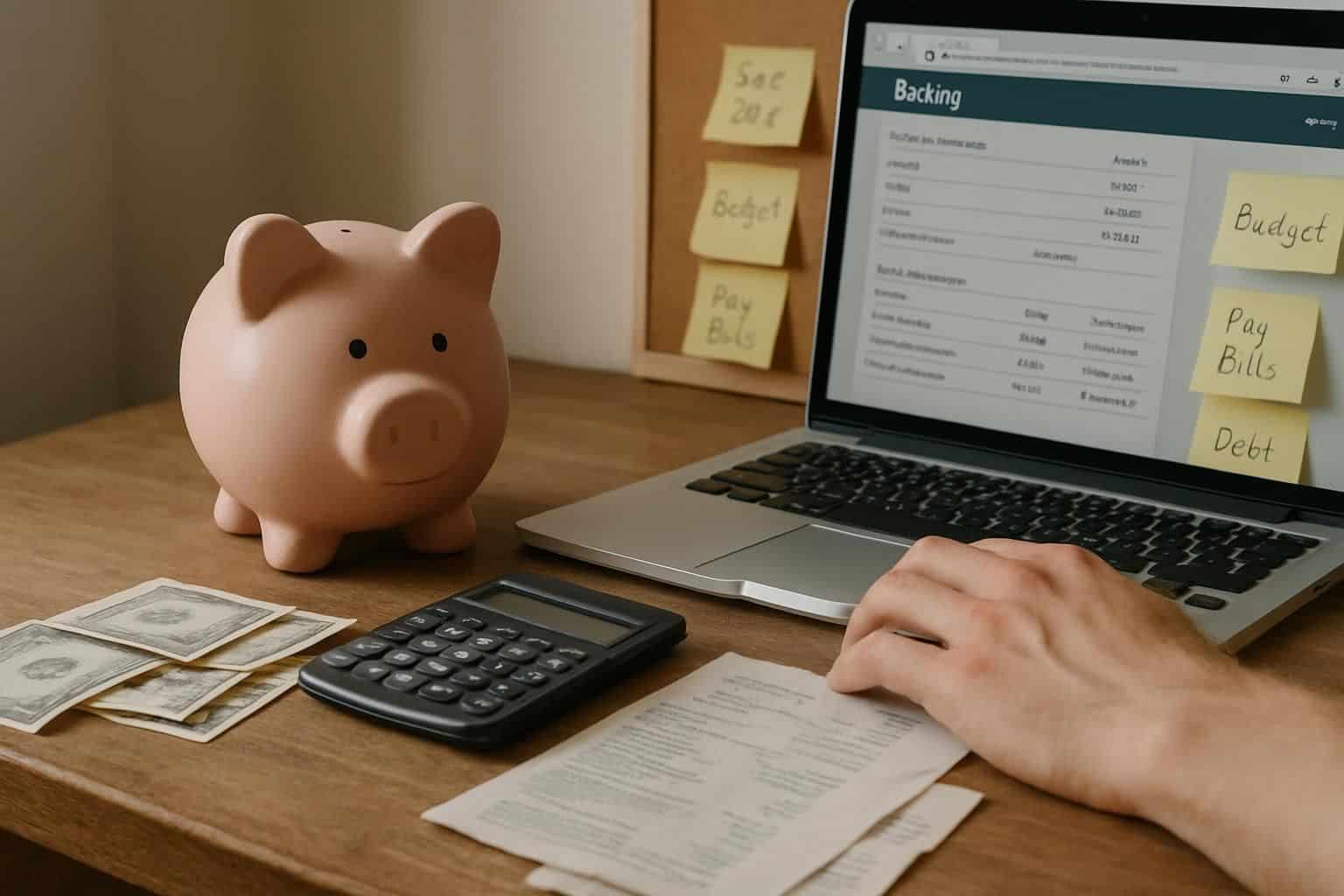Do you struggle with spending wisely and putting money into savings each month? You’re not alone; a NerdWallet survey found that 39% of working Americans save less than 20% of their paycheck.
With our clear smart spending tips, you’ll set easy savings goals, cut debt payments, and learn to track your expenses without fuss. Keep reading for simple ways to save more in 2025!
Key Takeaways
Try budgeting with the 50/30/20 method—allocate half your income to essentials, like rent and groceries, 30% to fun spending, and the remaining 20% to savings or debt payoff.
Set automatic transfers straight from your paycheck to savings, aiming to gradually build up an emergency fund covering three to six months of living costs—this approach keeps the money out of sight and out of mind.
Tackle expensive credit card debt first since high interest rates quickly eat away cash; think about transferring balances to cards offering promotional rates like 0% APR.
Reduce routine spending by ditching subscriptions you rarely use and trimming utility costs with small habits, like tweaking your thermostat settings and switching off unused lights.
Avoid impulse purchases by practicing the 30-day waiting rule; people who pause and reconsider often see a 25% reduction in spending on unplanned items.
Table of Contents
Create a Budget and Stick to It

A budget works as your money roadmap and helps you take control of your finances. You’ll need to list all income and expenses in a spending tracker, then make tough choices about what matters most to your bank account.
Separate Needs from Wants

Knowing the difference between needs and wants is the foundation of smart money habits. Needs are essentials—things like housing, food, health care, and utilities—that keep you healthy and secure.
Wants, meanwhile, include purchases like brand-name dresses, fancy dinners, or new electronic gadgets. To balance your money easily, use the 50/30/20 method: allocate 50% of your income to essentials, 30% to enjoyable extras, and 20% to debt or savings.
This easy breakdown helps show clearly if you’re spending too much on non-essential items.
The difference between a successful person and others is not a lack of strength, not a lack of knowledge, but rather a lack of will to control spending habits.
Putting necessities first boosts your financial stability and even benefits your credit rating. Lots of women notice that mobile banking apps make tracking everyday expenses simpler.
Before you purchase something, pause a second and think, “Is this something I actually need—or only something I’d enjoy having?” Doing this quick mental check often keeps impulse buys out of your online shopping cart.
By scaling back on non-essential spending, your emergency savings grow quicker, adding greater security to your finances.
Allocate Savings First

First, sort out what you truly need versus what you just want. Then, change how you handle money—pay yourself first, saving your income before spending. Making this small adjustment quickly adds up to more money in your savings account.
Aim to set aside at least 10-20% of your take-home earnings each paycheck, putting it away before you pay any bills. Keep enough savings to cover about three to six months of daily costs; this cushion helps you stay calm if things get tough.
Smart savers often automate this whole process, just to keep themselves on track. You can easily link your checking account to a savings account with higher interest rates for better returns.
A lot of banks offer these transfers for free, either through online options or easy-to-use mobile apps. Automatic transfers steadily build up your savings and still leave enough to cover regular expenses.
For another easy boost, put part of any tax refund directly into savings rather than spending it right away.
Set Clear Savings Goals

Setting specific money targets gives you a clear path for your financial journey. Your goals can range from saving for a new car next year to building a nest egg for retirement in 20 years.
Short-term Goals
Short-term goals boost your savings confidence with quick wins. Start small—try saving $500 for unexpected expenses, or stash away money bit by bit for holiday spending. Many women enjoy the 52-week savings plan, starting with $1 saved in week one, $2 in week two, and continuing until they have $1,378 at year’s end.
Your bank app is perfect for keeping tabs on progress, making the whole process easy.
Make sure each savings goal connects clearly to events happening in the next year. Perhaps your car needs new tires by next spring, or you plan to go on a weekend getaway this summer.
Automatic transfers simplify saving for these types of goals. Schedule direct deposits from your paycheck into different savings accounts—one for each specific target. This easy step lets you sidestep impulse purchases, as you steadily grow your emergency savings fund.
Long-term Goals
Looking past immediate goals, your long-range financial plans set you up for future success. Typically, these are goals you aim for five years down the road—or even longer. Examples include buying your dream home, paying for your kids’ college, or building up retirement funds.
A useful tip many women use is setting separate investment accounts for each big goal, helping them easily track their progress. Building an emergency fund matters too—a cushion holding three to six months’ worth of expenses helps you handle surprise situations stress-free.
A goal without a plan is just a wish. Your long-term financial goals deserve more than wishful thinking.
Savvy women balance debt repayment with saving for future needs. Popular approaches, like the Snowball or Avalanche methods, can boost credit scores and free up money to invest elsewhere.
Checking your financial progress consistently keeps you accountable, letting you adjust your approach whenever needed. Personally, a vision board inspires me during tough saving periods; seeing visuals of my ideal retirement or future house keeps motivation going strong.
Track Your Spending Regularly

Money disappears quickly if you’re not careful. Every month, I keep an eye on what I spend—this simple habit has saved me hundreds. Knowing your earnings and spending gives you better control of your finances.
Many women discover unexpected costs by tracking daily expenses through banking apps or spending trackers. That morning coffee routine alone might cost as much as $100 a month! Regular expense tracking helps reveal easy ways to cut back, without feeling deprived.
Taking charge of your finances can even boost your credit score. Last year, I started writing down every purchase in a small notebook and noticed $75 a month going toward subscriptions I never used.
Little adjustments like these lead to significant savings down the road.
Automate Your Savings

Automating your savings takes the guesswork out of building your nest egg. Set up direct deposits from your paycheck to your emergency fund or investment accounts, and watch your money grow without lifting a finger.
Set Up Automatic Transfers to Savings
Automatic bank transfers make saving money simple and stress-free. You pick the schedule, and your bank moves money from your checking to your savings automatically—no extra effort needed.
Many women like this approach because savings become just another bill, one you pay first.
You can even set transfers for specific financial goals. Maybe you want a safety net for surprise vehicle repairs, or perhaps you’re dreaming of a sunny beach getaway. Just create separate transfers for each goal—it’s that easy.
Online banking tools also make the setup fast, simple, and stress-free.
Now, let’s talk about the benefits of staying financially flexible through a line of credit. This can give your money plan some valuable breathing room.
Maintain Financial Flexibility with a Line of Credit
Setting up automatic transfers helps you build savings steadily—but life has unexpected surprises. It’s important to have a backup plan ready for those moments. A line of credit offers flexibility when money feels tight.
Unlike fixed-term loans, this financial option lets you borrow exactly what you need, exactly when you need it. Interest applies only on the amount you actually borrow, rather than on your total credit limit.
Many women rely on this option for unexpected medical bills or car repairs, letting them protect their emergency savings.
Good money management involves having practical solutions ready before financial emergencies appear. A personal credit line acts as a quiet safety net, ready and waiting for sudden costs.
This lets your regular savings stay untouched, even as you manage unexpected bills. NinjaCard provides flexible credit solutions that complement your savings goals.
Having these options available keeps your financial foundation stable, even if life tosses surprises into your path.
Reduce High-interest Debt

High-interest debt eats away at your money faster than you can save it. Pay off your credit cards first, then look into better rates for your loans to stop the bleeding and start building wealth.
Pay Off Credit Cards Faster
Credit card debt quietly drains away money through interest payments. A while back, I transferred my balance onto a card offering 0% APR for a promotional period of 12 to 21 months.
This straightforward approach helped me save hundreds of dollars in interest and provided breathing space to tackle my debt comfortably. Making extra payments whenever you can—even a few dollars here and there—really helps speed things along.
Last year, I used my tax refund and birthday cash to reduce my balance, shaving six months off my repayment schedule.
Savvy women tackle debt from several directions, keeping options open. One effective strategy is the debt avalanche method. Pay minimum amounts on all cards, but devote any extra cash to the card charging the highest interest rate first.
Your credit score improves steadily as you chip away debt. Many banks also offer helpful online tools to track your spending habits, clearly displaying monthly expenses. These simple tracking features help uncover extra cash you didn’t know existed.
Even small savings of just $50 each month can significantly shorten your journey to becoming debt-free.
Refinance Loans if Possible
Loan refinancing can be a powerful tool—especially for women dealing with high interest rates—to regain control over their finances. Federal direct undergraduate loan rates rose sharply this year to 6.53%, up from last year’s 5.5%.
With this increase, refinancing becomes an appealing choice, lowering monthly payments and reducing total interest. Your credit score can strongly affect potential loan offers, so reviewing your credit report carefully beforehand is crucial.
Refinancing your student loans could be the financial reset button you didn’t know you needed.
Timing your refinance right can make all the difference. Interest rates shift regularly due to market changes, so keep an eye out through banking apps or financial websites to pick the ideal moment.
Many lenders provide special deals during holiday periods—like Presidents’ Day or Black Friday—including lower fees or cash-back bonuses. Savings from refinancing at the right moment can quickly add to your emergency fund or speed up other financial targets you have in mind.
Cut Monthly Expenses

Monthly bills can eat up your paycheck faster than you realize. A quick review of your regular expenses often reveals hidden costs you can trim without changing your lifestyle.
Cancel Unnecessary Subscriptions
It’s easy to overlook monthly subscriptions. They quietly drain your bank balance without you noticing. Last month alone, I cut $87 in costs by canceling services I rarely used. Go through every streaming platform, subscription app, or membership carefully.
Figure out what’s actually worth keeping and get rid of the rest. Lots of people sign up for free trials and forget to cancel later—I know I’ve done it plenty. Make a clear list of every subscription and its monthly cost, then cross out anything you hardly ever touch.
And don’t forget promotional emails; those flashy sale notices encourage impulse shopping, eroding your savings goals. Digital platforms usually make cancellation simple through your online banking app or their account settings.
Tracking these sneaky, small expenses boosts your money sense and quickly adds to savings.
These subscription services rely on your forgetfulness—I once paid for three separate music services at the same time without even realizing. To keep an eye on charges, set reminders every three months in your budgeting app to check what you’re subscribed to.
Companies often quietly bump their prices, hoping you won’t catch it on your credit card bill. If an online cancellation gives you issues, just call their customer service line; often they’ll offer deals to convince you to stay.
Accepting a discount can work in your favor, but only if the service genuinely benefits your life. Once you cut those recurring charges that aren’t helping your short-term goals, your emergency fund grows much quicker.
Save on Utility Bills
You can easily shrink your monthly utility bills by making small, smart changes around your home. Last year, I lowered my electricity expenses by 30%—I started using energy-saving appliances and added smart power strips to cut down phantom energy use.
The EPA confirms that improving home insulation can reduce energy bills by about 15%, saving homeowners hundreds of dollars each year. Adjust your thermostat by just a couple of degrees, even slightly, and your savings will steadily increase.
Most power companies offer free home energy audits, helping you find hidden areas of waste.
Little habits around your house bring surprising gains to your budget. Switch off lights as you leave a room, fix any dripping faucets, and wash your clothes in cold water to reduce heating costs.
Last winter, my neighbor set up a smart thermostat and ended up cutting $220 off her heating bill. You can lower water consumption with inexpensive upgrades like faucet aerators and low-flow showerheads.
Simple changes like these let you enjoy serious monthly savings—without giving up your comfort.
Shop Smartly

Smart shopping saves more cash than most women realize. You can stretch your dollars further with a few simple tricks that make a big difference to your bank account.
Use the 30-day Rule for Purchases
The 30-day rule puts an immediate hold on impulse purchases. This simple yet effective method requires waiting 30 days before buying something non-essential. I used this strategy myself last month, after seeing a lovely dress online priced at $85.
Instead of hitting the “buy now” button, I placed it on my wishlist and marked the date in my planner. After a full month passed, I realized the dress wasn’t something I truly needed—my closet was already full enough! By forcing you to pause before spending, the 30-day rule boosts your financial knowledge and helps build your emergency fund faster.
In fact, many women report saving at least 25% on unnecessary items using this approach.
You can easily test the 30-day strategy with your next tempting find. Simply jot down the item’s name, the cost, and today’s date. Then, set yourself a calendar reminder exactly one month from now.
If that day arrives and you still desire the item, it shows the purchase isn’t driven purely by impulse. That waiting period allows your brain some downtime—away from the excitement of shopping—to decide if the item fits your real financial goals.
Your bank account will breathe easier, and your home won’t become cluttered with unnecessary stuff.
Take Advantage of Discounts and Coupons
Savvy shoppers understand how valuable discounts and coupons can be. Loyalty programs and digital coupons from your local grocery stores can significantly lower your spending. Many retailers also provide cash-back offers within their mobile apps for buying specific products.
Spending just five minutes to glance at advertised deals before hitting the store can save you a lot later. This easy habit prevents those impulsive buys that quickly destroy your family budget.
Meal planning and coupon use go perfectly together to save even more money. First, check what’s on sale that week—then build your meals around those ingredients, making sure you have matching coupons.
Combining discounts and meal planning typically reduces your monthly grocery bill by as much as 20–30%. Plus, shoppers who follow this approach usually waste less food—saving extra cash and helping the environment at the same time.
For clothing and home goods, consider checking out consignment or secondhand stores. Thrift shops frequently have items marked down 50–70% off regular retail prices.
Minimize Transportation Costs

Transportation costs can eat up a big chunk of your monthly budget if you’re not careful. Smart choices about how you get around can lead to major savings over time.
Carpool or Use Public Transit
Splitting rides with friends or coworkers gives your budget a nice boost. You save on gas costs, reduce car wear, and cut down repair expenses in the long run. Even carpooling two days a week is enough for many women to shrink monthly commuting costs by 15-20%.
Public transit can put even more cash back in your pocket. Monthly passes for buses or subways frequently cost less than filling your gas tank each month. Plus, transit rides give you downtime—to relax, check emails, or catch up on reading—instead of battling stressful traffic.
Choosing shared travel cuts costs and helps the planet, too. Most city bus and train services now have mobile apps that make checking schedules a breeze. A lot of companies also offer transit perks, like subsidies or pre-tax savings, to lower commuting expenses further.
Banks like Bank of America will sometimes even give cash-back rewards for buying transit passes with their credit cards. These savings stack up quickly, making shared travel a savvy financial choice for 2025.
Maintain Your Vehicle Efficiently
Carpooling is great for cutting gas costs—but giving your car regular care can save you even more money over time. Basic vehicle upkeep keeps away surprise breakdowns and costly repairs.
Regular oil changes, tire rotations, and fluid checks help your car stay reliable for years to come. It’s also smart to set aside around $50 to $100 each month, just in case unexpected trouble pops up.
Having this small cushion handy prevents resorting to credit cards, protecting your credit score while growing an emergency fund.
Taking good care of your vehicle boosts gas mileage too. Checking tire pressure once a month can improve fuel efficiency by as much as 3%, saving you more cash at the pump. Make sure your air filter stays clean, since a dirty filter drags engine performance down.
Many mechanic shops offer free inspections, and certain auto-part stores will even test your battery’s condition for free. You’d be surprised how these little habits can shrink your monthly transportation budget and get you closer to your savings targets faster.
Opt for Affordable Entertainment

Fun doesn’t need to drain your wallet in 2025. You can enjoy movies, music, and events without spending a fortune on tickets or memberships.
Explore Free Local Events
Local events can offer amazing fun—and the best part—they cost nothing. I’ve discovered incredible concerts, art shows, and festivals by simply browsing community bulletin boards and local Facebook groups.
Most cities hold free outdoor movie nights during summer months and holiday markets during winter, all totally free to attend. Your tax money already covers many of these public activities, so you might as well take advantage of them! Social platforms like Instagram and Twitter are great places to find free happenings by following city-related hashtags.
Plus, local libraries and parks departments often host free classes and workshops—which lots of folks don’t even know about.
These events help you build connections in your neighborhood without putting a dent in your budget. My family saved more than $200 last month by choosing free park concerts over dinners out.
Many local museums even provide free entry days every month—a great option for an educational family day trip! The best thing about this approach is simple: you still get great entertainment, while saving dollars to put into your emergency or investment funds instead.
For an easy way to get started, visit your city’s official website or download local event apps to see what’s happening nearby this weekend.
Cook at Home Instead of Dining Out
Your kitchen itself offers a great way to save money—beyond attending free community activities. Restaurant meals generally cost much more than eating at home. According to The Harris Poll, more folks are now choosing to cook meals themselves, as restaurant prices continue to rise.
By preparing basic meals at home instead of ordering takeout, I saved more than $200 every month. To cut back on waste, plan weekly menus before heading to the store. The USDA predicts food prices will go up by 1.9% in 2025, increasing the value of home-cooked meals for your budget.
Make your pantry your friend. Rice, beans, and frozen veggies last longer and are easy to use in many dishes. Cooking your own food lets you choose what goes into each dish, and also allows you to keep portions in check.
This means you’ll spend less money and enjoy healthier meals, boosting your savings and physical well-being. Mobile banking apps today usually have spending trackers built in, clearly showing how much you spend on food.
With that information, setting a realistic grocery budget becomes much simpler.
How Will Personal Finance Strategies Evolve in 2025?
Personal finance tools are set to evolve significantly by 2025. Banks will provide mobile apps that clearly track spending and savings, all in real-time. These apps will neatly organize expenses into easy-to-follow categories, making budgeting simpler than ever.
Tools like the 50/30/20 budgeting method will become increasingly common—setting aside 50% of income for basic needs, 30% for enjoyable extras, and 20% straight into savings. For many women, especially those dealing with single mom challenges, that rule gives practical guidance for handling tight budgets.
Savings-focused games will also become popular, turning money-saving habits into a more enjoyable and rewarding experience.
Automatic saving will play a bigger role in 2025, making it simple and stress-free. Direct deposit arrangements will split paychecks automatically across multiple accounts—no extra effort needed.
The “no buy rule” will help many women avoid impulsive spending by encouraging a waiting period before purchasing non-essential items. Good credit management will emphasize paying credit card balances in full each month, avoiding pricey interest charges and raising credit scores.
Banks will share clearer, free financial guides covering useful topics like health savings accounts (HSAs) and certificates of deposit (CDs). I personally started automatic transfers last year, managing to put away $2,400—and barely noticed it gone from checking.
People Also Ask
What are the best ways to build an emergency fund in 2025?
Use automatic transfers from your paycheck into a separate savings account. Pick banks with better interest rates—check out options like certificates of deposit for cash you won’t immediately spend. Set simple savings goals, and track your progress using budgeting and spending apps.
How can I reduce my fixed monthly expenses?
Look over subscriptions regularly, and cancel any you hardly use. Every six months, shop around for better car insurance rates—you might find cheaper deals. Also, switching to energy-efficient appliances can gradually lower your utility bills.
What money-saving challenges work best for beginners?
Try the “no impulse shopping” challenge to stop unplanned purchases. Thrift stores and consignment shops can help you save money instead of buying new. You can also pick certain days as “no-spend days”—no optional spending allowed—to build good habits.
How can I use tax refunds wisely?
Use your refund money to both pay down debt and build your savings. If your financial goals are farther down the road, investing in mutual funds can be smart. Always hold onto some cash for unexpected bills and purchases.
Will improving my credit score really help me save money?
Absolutely. Better credit scores mean lower interest rates, and that means paying less on mortgages, refinances, or auto loans. Over the life of these loans, a high credit score could save you thousands of dollars.
What special shopping days should I target for maximum savings?
Plan your bigger buying around Presidents’ Day, Veterans Day, or Black Friday—stores offer big discounts then. Retailers typically offer price cuts and rebates during these times to clear out inventory.
References
https://www.usatoday.com/story/money/2025/04/22/how-to-make-a-budget/83144634007/ (2025-04-22)
https://www.quicken.com/blog/14-best-ways-to-save-money/
https://www.synchrony.com/blog/bank/financial-resolution-tips (2024-12-31)
https://www.voya.com/blog/23-ways-people-can-save-money-money-daily
https://www.bankrate.com/banking/savings/ways-to-save-more-this-year-savings/
https://www.eastrise.com/blog/ten-ways-automatic-transfers-help-you-save-more-money/ (2023-10-25)
https://www.cbsnews.com/news/how-to-pay-less-interest-on-credit-card-debt-in-2025/
https://research.com/student-loans/should-i-refinance-my-student-loans
https://finance.yahoo.com/personal-finance/banking/article/30-day-savings-rule-210839516.html (2024-10-15)
https://www.youcandealwithit.com/borrowers/managing-money/saving/reduce-transportation-costs
https://www.experian.com/blogs/ask-experian/how-to-reduce-car-expenses/ (2024-01-26)
https://www.hellobrigit.com/learn/how-to-save-money-on-entertainment
https://savingsgrove.com/blogs/guides/how-to-save-money-on-entertainment (2024-12-17)
https://finance.yahoo.com/personal-finance/banking/article/how-to-save-money-193015616.html
